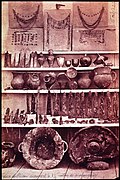Troy
Troy [1][2] was a city in north-west Asia Minor. It was the center of the Trojan War, as told in eight long epic poems, six from the Epic Cycle,[3] and two written by Homer, the Iliad and the Odyssey.[4]
Today it is the name of an archaeological site, the location of Homeric Troy, in Hisarlik in Anatolia, close to the seacoast in what is now Çanakkale province in northwest Turkey, southwest of the Dardanelles.
UNESCO has listed the archaeological site of Troy as a World Heritage Site.
- "The archaeological site of Troy is of immense significance in the understanding of the development of European civilization at a critical stage in its early development. It is, moreover, of exceptional cultural importance because of the profound influence of Homer’s Iliad on the creative arts over more than two millennia". UNESCO citation.[5]
Homer's Troy
Troy as seen in Homer's account is probably true in part. However, it is wrong to think his account is historically exact. With that warning, this is a summary of events leading up to the Trojan war, mostly derived from the Iliad.
Troy was a powerful kingdom in the Mediterranean sea, and thrived under the long rule of King Priam. His many sons, including the valiant, strong, unbeatable Hector, and Paris, a creative character who was not a strong fighter but a passionate man, are the best known in the Troy myth.
In Greece lay a Kingdom called Mycene, owned by Mycenaean or Mykene people, ruled by King Agamemnon. He started a campaign to pressure the Greece cities or kingdoms and to join him and attack Troy, to capture its many riches. The King of Ithaca, Odysseus (or Ulysses, as he was also known), along with King Idomenous of Crete, with up to 22 more Kingdoms and Kings, spent ten years attacking Troy. Eventually, Troy fell after a coup that Odysseus had thought up, using a wooden trojan horse to hide soldiers within in order to get soldiers behind the Trojan line of defence.
Before the fall of Troy, during the dawn of the War, King Priam sought to create an alliance with the strong Kingdom of Sparta in Northern Greece, to defend Troy when the war had begun. King Aeneas, or Helikaon as he was said to be known, King of Dardanos, was a good friend of Hektor and King Priam, and sided with the Trojans in the war. Unfortunately, on the journey back, after Hektor and Paris had forged an alliance in Sparta, Paris took the wife of the King of Sparta, Princess Helen, without his consent, as they had fallen in love. This ended the alliance,and Sparta eventually joined the fighting cause of King Agammenon.
Troy Media
"Schliemann's Trench". Layers are marked with Roman numerals.
Golden bottle and goblets from Priam's Treasure. Pushkin Museum
Artifacts which Schliemann dubbed Priam's Treasure.
References
- ↑ Greek: Τροία, Troia, also Ίλιον, Ilion; Latin: Trōia, Īlium. Trōia is the preferred Latin name for the city. Ilium is a more poetic term. Hittite: Wilusa or Truwisa; Turkish: [Truva] Error: {{Lang}}: text has italic markup (help).
- ↑ Lewis, Charlton T.; Charles Short. "Ilium". A Latin Dictionary. Tufts University: The Perseus Digital Library.
- ↑ The poems of the Epic Cycle only survive in fragments.
- ↑ March, Jenny (2008). The Penguin Book of Classical Myths. Penguin Books. p. 294. ISBN 978-0-141-02077-8.
- ↑ UNESCO citation
Other websites
General
- Troy on the Internet Archived 2008-05-14 at the Wayback Machine Educational website, University of Cincinnati
- The Identification of Troy by Jan Sammer
- Troy -Citizendium
- "Troy, archaeology and the Old Testament". Is there a God?. 7 March 2017.
Archaeology
- Hisarlık Troy Archived 2008-05-16 at the Wayback Machine
- Project Troia - The new excavations at Troy Archived 2005-05-19 at the Wayback Machine
- digital reconstructions of the city Archived 2007-03-11 at the Wayback Machine
- Greek, Roman and Byzantine Pottery at Ilion (Troia) Archived 2011-06-07 at the Wayback Machine
- Troy VII and the Historicity of the Trojan War Archived 2006-04-11 at the Wayback Machine
Photos
- Photos from Troy
- Troy pictures Archived 2007-02-20 at the Wayback Machine
- Livius.org: Troy and plain of Troy Archived 2009-02-27 at the Wayback Machine
Geography
- the Troad Archived 2001-11-30 at the Wayback Machine (with an image of a model of Troy II)
- Geology corresponds with Homer’s description of ancient Troy, article by Neil Thomas on the University of Delaware site.
![]()











